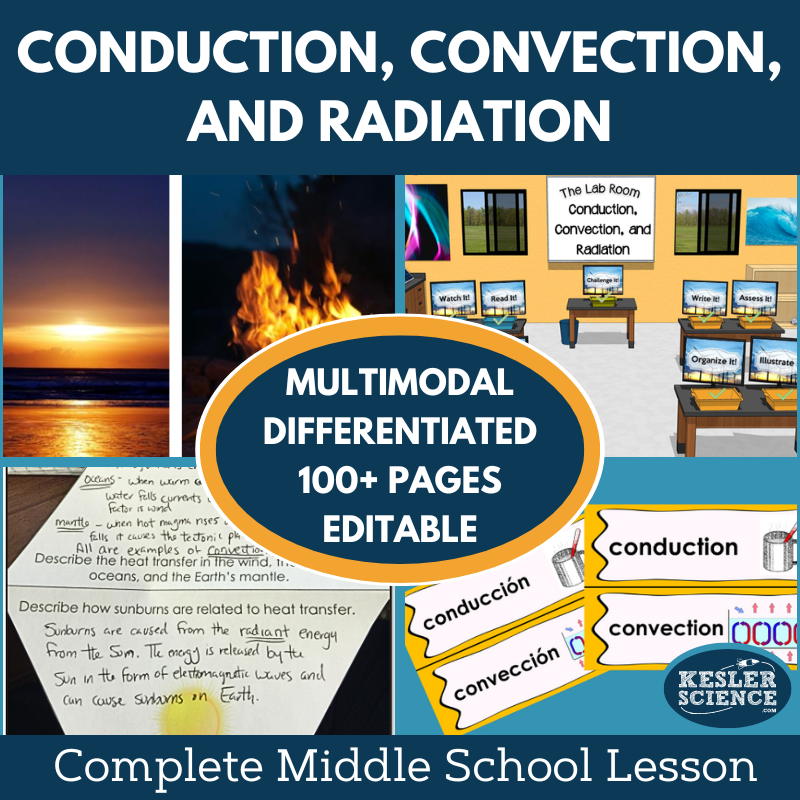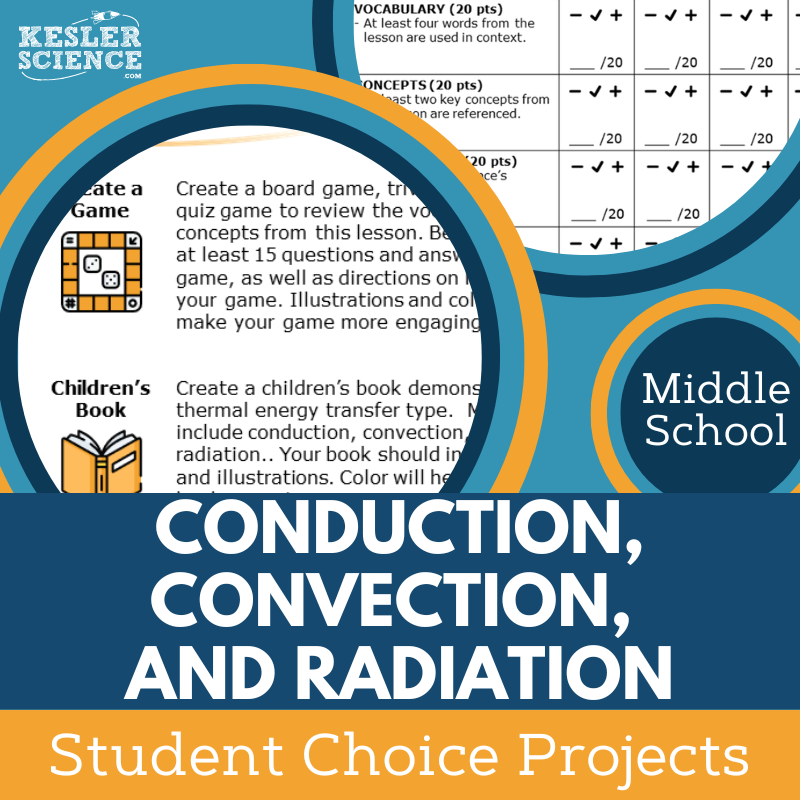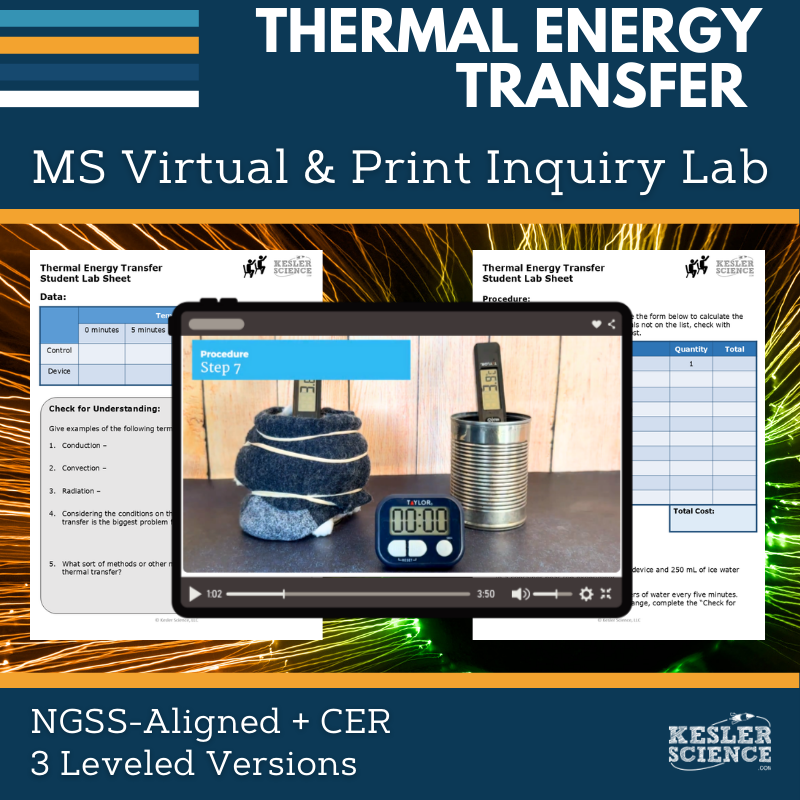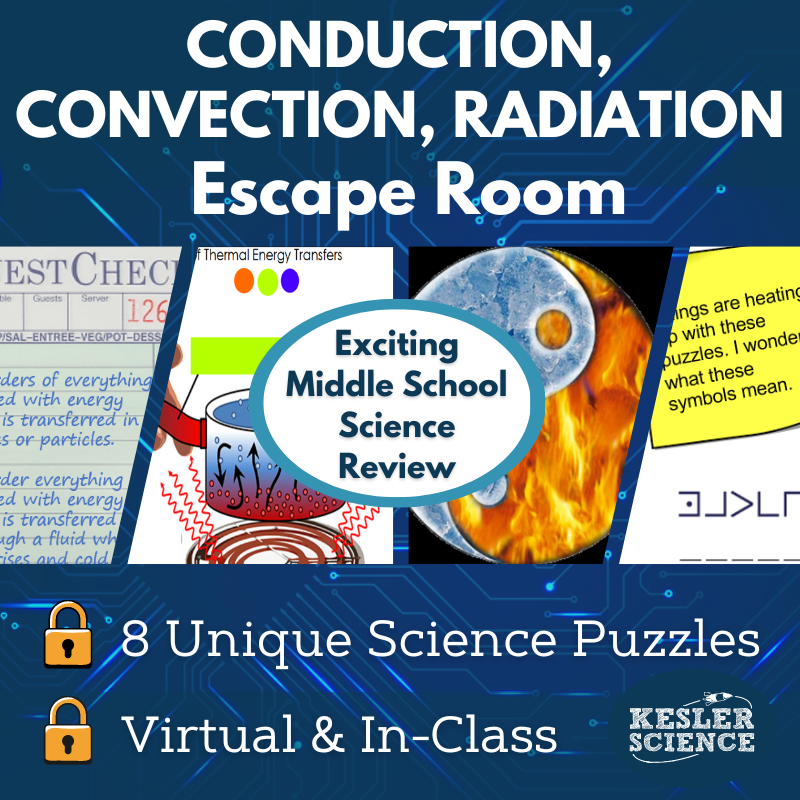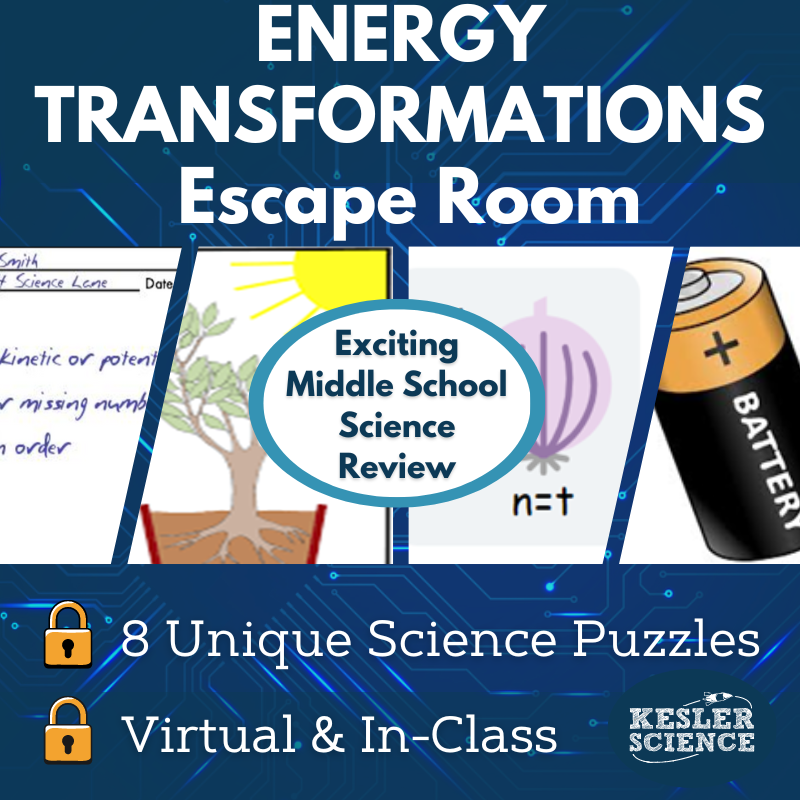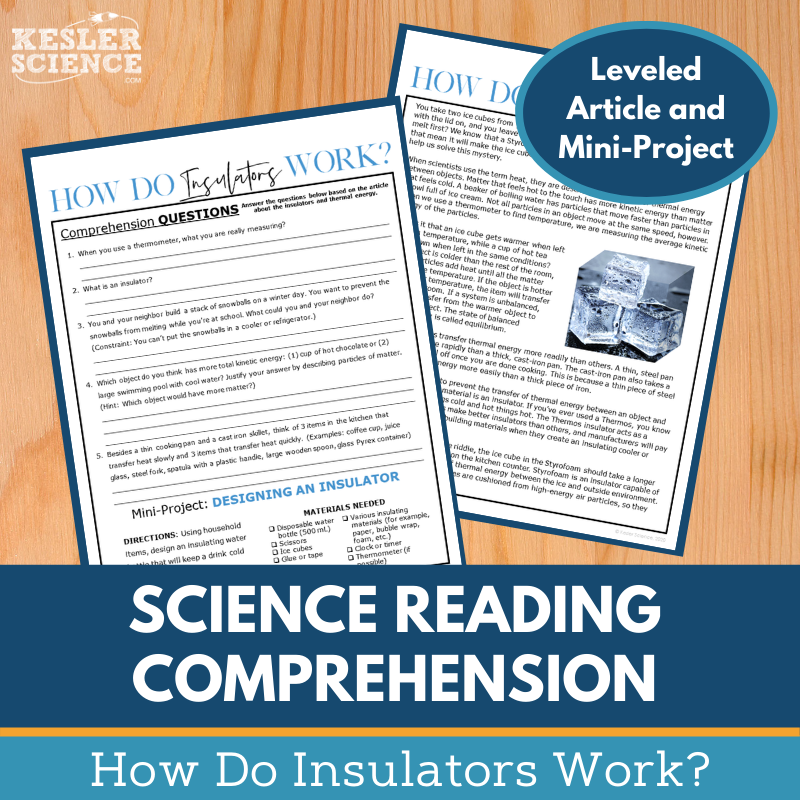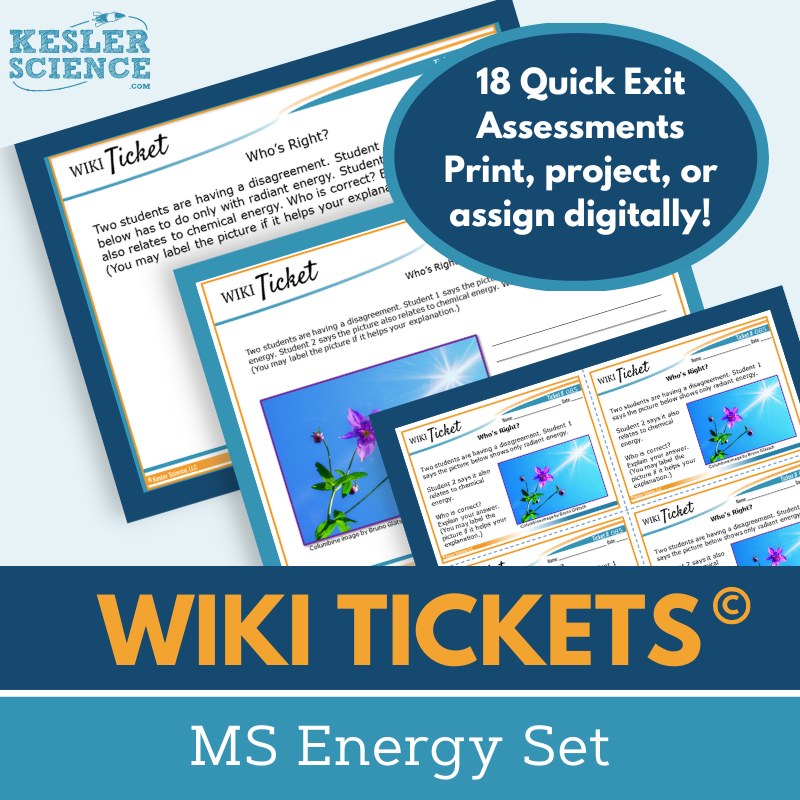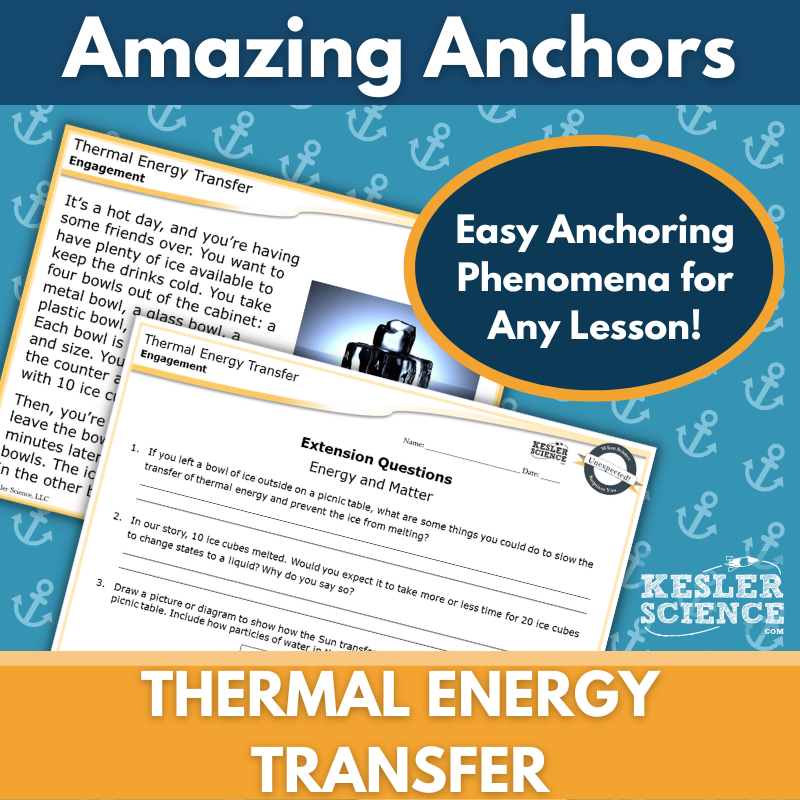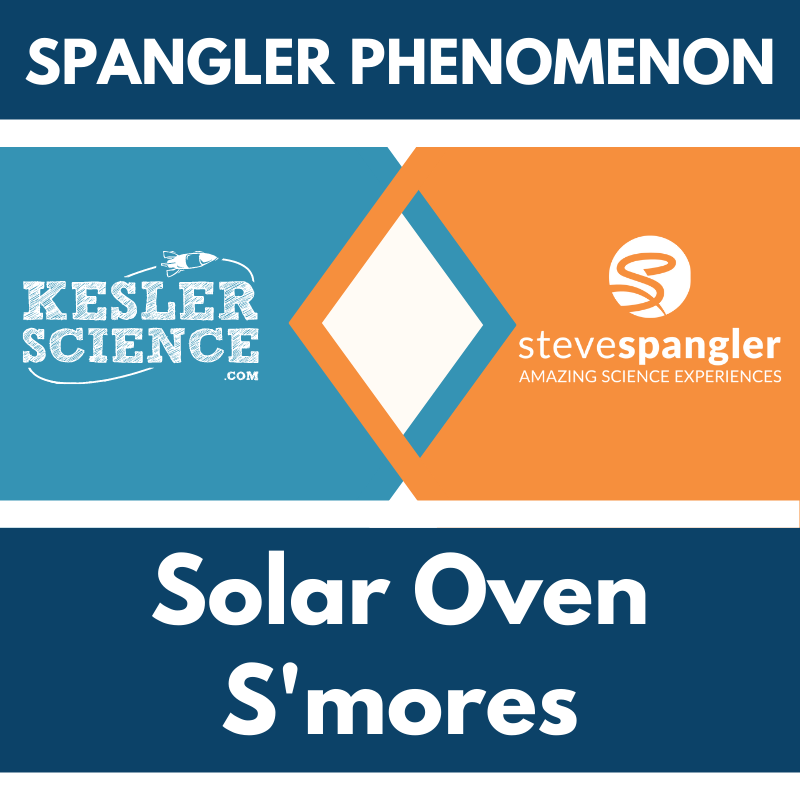Thermal Energy Transfer Activities for Middle School Science
Understanding thermal heat transfer is essential in science, and this engaging 5E lesson helps middle school students explore conduction, convection, and radiation through interactive and student-led activities. The resources below will give students a comprehensive understanding of thermal energy transfer. All of the following materials are also included in the Kesler Science Membership.
The Kesler Science Conduction, Convection, and Radiation 5E Lesson is a fully editable, engaging middle school unit with presentations, worksheets, choice projects, and assessments requiring minimal prep. Designed for differentiated, student-led learning, it aligns with NGSS and TEKS standards and includes Spanish translations of key materials.
The unit follows the 5E Model, beginning with engagement activities, word wall cards, and discussion prompts. The exploration phase features a student-led station lab with multimodal input and output activities, including hands-on demos, reading passages, videos, and digital interactions. Explanation includes editable PowerPoints, interactive notebooks, and note-taking templates. Elaboration allows students to extend learning through choice projects, while evaluation includes STAAR 2.0-aligned assessments, review questions, and worksheets.
With flexible formats for printable and digital use, this lesson supports both in-class and virtual learning environments.
The Kesler Science Conduction, Convection, and Radiation 5E Lesson is a fully editable, engaging middle school unit with presentations, worksheets, choice projects, and assessments requiring minimal prep. Designed for differentiated, student-led learning, it aligns with NGSS and TEKS standards and includes Spanish translations of key materials.
The unit follows the 5E Model, beginning with engagement activities, word wall cards, and discussion prompts. The exploration phase features a student-led station lab with multimodal input and output activities, including hands-on demos, reading passages, videos, and digital interactions. Explanation includes editable PowerPoints, interactive notebooks, and note-taking templates. Elaboration allows students to extend learning through choice projects, while evaluation includes STAAR 2.0-aligned assessments, review questions, and worksheets.
With flexible formats for printable and digital use, this lesson supports both in-class and virtual learning environments.
Engage your middle school students with this student-led station lab on conduction, convection, and radiation. Designed to encourage independent learning, this modular activity helps students develop a model predicting and describing changes in particle motion, temperature, and state of pure substances.
This lab includes nine interactive stations, each with differentiated activities to support various learning styles. Input stations introduce concepts through hands-on demonstrations, research, reading passages (available in English and Spanish), and videos. Output stations allow students to demonstrate their understanding by organizing information, illustrating models, writing responses, and completing assessments. A bonus challenge station provides extension activities for early finishers.
With all necessary signage, literature, resources, and task cards included, students can work independently or in small groups, whether in class or virtually. This low-prep, high-engagement resource fosters active learning and critical thinking.
Engage your middle school students with this student-led station lab on conduction, convection, and radiation. Designed to encourage independent learning, this modular activity helps students develop a model predicting and describing changes in particle motion, temperature, and state of pure substances.
This lab includes nine interactive stations, each with differentiated activities to support various learning styles. Input stations introduce concepts through hands-on demonstrations, research, reading passages (available in English and Spanish), and videos. Output stations allow students to demonstrate their understanding by organizing information, illustrating models, writing responses, and completing assessments. A bonus challenge station provides extension activities for early finishers.
With all necessary signage, literature, resources, and task cards included, students can work independently or in small groups, whether in class or virtually. This low-prep, high-engagement resource fosters active learning and critical thinking.
The Conduction, Convection, and Radiation Student Choice Projects lesson allows middle school students to select a project that aligns with their preferred output style. A project page outlines six student-led options plus a “design your own” project, with an editable rubric for teacher, peer, or self-assessment.
These flexible, multimodal projects provide creative ways for students to demonstrate their understanding. Two versions of the project page support differentiation, with modified options for students needing remediation and challenge opportunities for advanced learners. Teachers can adjust the rubric to fit grading needs.
The projects use standard classroom supplies such as paper, markers, and scissors, with many options available for digital completion. Some crafting supplies may be helpful for building models.
The Conduction, Convection, and Radiation Student Choice Projects lesson allows middle school students to select a project that aligns with their preferred output style. A project page outlines six student-led options plus a “design your own” project, with an editable rubric for teacher, peer, or self-assessment.
These flexible, multimodal projects provide creative ways for students to demonstrate their understanding. Two versions of the project page support differentiation, with modified options for students needing remediation and challenge opportunities for advanced learners. Teachers can adjust the rubric to fit grading needs.
The projects use standard classroom supplies such as paper, markers, and scissors, with many options available for digital completion. Some crafting supplies may be helpful for building models.
The Thermal Energy Transfer Inquiry Lab aligns with NGSS MS-PS3-3, guiding students to explore how engineers prevent thermal energy transfer. This flexible lab includes both a virtual demonstration with a pre-recorded video and a hands-on printed experiment. Both versions feature comprehension questions, Claim-Evidence-Reasoning (C.E.R.) prompts, and a reflection section.
Students observe how thermal energy transfers between mediums using differentiated versions at three levels: dependent (guided inquiry), modified (structured with supports), and independent (student-led exploration). The print format includes a hands-on experiment with materials such as thermometers, metal cans, cotton balls, fabric pieces, ice water, and natural insulators. The digital format is an interactive PowerPoint compatible with Google Slides and integrates a full video demonstration, allowing students to follow along.
This resource includes editable PowerPoints, teacher resource pages, answer keys, and differentiated materials to support all learners. The lab offers flexibility with both printable and digital formats, making it an engaging, multimodal learning experience for middle school students.
The Thermal Energy Transfer Inquiry Lab aligns with NGSS MS-PS3-3, guiding students to explore how engineers prevent thermal energy transfer. This flexible lab includes both a virtual demonstration with a pre-recorded video and a hands-on printed experiment. Both versions feature comprehension questions, Claim-Evidence-Reasoning (C.E.R.) prompts, and a reflection section.
Students observe how thermal energy transfers between mediums using differentiated versions at three levels: dependent (guided inquiry), modified (structured with supports), and independent (student-led exploration). The print format includes a hands-on experiment with materials such as thermometers, metal cans, cotton balls, fabric pieces, ice water, and natural insulators. The digital format is an interactive PowerPoint compatible with Google Slides and integrates a full video demonstration, allowing students to follow along.
This resource includes editable PowerPoints, teacher resource pages, answer keys, and differentiated materials to support all learners. The lab offers flexibility with both printable and digital formats, making it an engaging, multimodal learning experience for middle school students.
The Heat Transfer Escape Room is an interactive activity that allows students to explore conduction, convection, and radiation in an engaging way. Designed to align with NGSS and TEKS standards, this escape room challenges students to investigate thermal energy transfer and its predictable movement from warmer to cooler substances.
Teachers have full control over the eight independent puzzles, allowing customization based on class duration and student needs. The activity can be conducted using manila envelopes and passwords or a more authentic lock-and-box setup. A digital version is available for online learning via PowerPoint or Google Slides, with printable versions for home use.
The resource includes teacher directions, a detailed answer key, a digital answer sheet, and an editable teacher version. Additional features include a video challenge, printable props, reward templates, and over 50 prize ideas, ensuring an immersive and exciting learning experience.
The Heat Transfer Escape Room is an interactive activity that allows students to explore conduction, convection, and radiation in an engaging way. Designed to align with NGSS and TEKS standards, this escape room challenges students to investigate thermal energy transfer and its predictable movement from warmer to cooler substances.
Teachers have full control over the eight independent puzzles, allowing customization based on class duration and student needs. The activity can be conducted using manila envelopes and passwords or a more authentic lock-and-box setup. A digital version is available for online learning via PowerPoint or Google Slides, with printable versions for home use.
The resource includes teacher directions, a detailed answer key, a digital answer sheet, and an editable teacher version. Additional features include a video challenge, printable props, reward templates, and over 50 prize ideas, ensuring an immersive and exciting learning experience.
The Energy Transformations Escape Room is an interactive experience that helps students demonstrate their understanding of how energy transforms from one type to another. Designed to align with NGSS standards, this activity allows students to explore energy changes, such as chemical energy converting to electrical and light energy in a flashlight.
Teachers have full control over the eight independent puzzles, allowing customization to fit different class periods. The escape room can be set up using manila envelopes for a simple implementation or enhanced with locks and a storage box for a more immersive experience. Digital versions are available for online learning through PowerPoint or Google Slides, with printable options for home use.
This resource includes teacher directions, a detailed answer key, a digital answer sheet, video challenges, and engaging printable props. Students will stay engaged with reward templates, over 50 prize ideas, and themed signs for a fun photo finish. This escape room transforms learning into an exciting challenge that students will remember long after the activity ends.
The Energy Transformations Escape Room is an interactive experience that helps students demonstrate their understanding of how energy transforms from one type to another. Designed to align with NGSS standards, this activity allows students to explore energy changes, such as chemical energy converting to electrical and light energy in a flashlight.
Teachers have full control over the eight independent puzzles, allowing customization to fit different class periods. The escape room can be set up using manila envelopes for a simple implementation or enhanced with locks and a storage box for a more immersive experience. Digital versions are available for online learning through PowerPoint or Google Slides, with printable options for home use.
This resource includes teacher directions, a detailed answer key, a digital answer sheet, video challenges, and engaging printable props. Students will stay engaged with reward templates, over 50 prize ideas, and themed signs for a fun photo finish. This escape room transforms learning into an exciting challenge that students will remember long after the activity ends.
This How Do Insulators Work Science Reading Comprehension Lesson helps students explore how insulators work through a nonfiction article and a hands-on design challenge. Designed for middle school, the leveled passage supports science literacy and reading comprehension.
The resource includes two leveled articles (Lexile 1100-1300), five to seven comprehension questions, a hands-on mini-project to design an insulating water bottle, and a Cornell notes template. It features engaging, printable graphics and is compatible with Google Classroom, MS Teams, Schoology, and Canvas for virtual learning.
Ideal for sub plans, ISS, extra credit, or whole-class instruction, this resource fosters critical thinking, classroom discussions, and textual analysis while reinforcing key heat transfer concepts.
This How Do Insulators Work Science Reading Comprehension Lesson helps students explore how insulators work through a nonfiction article and a hands-on design challenge. Designed for middle school, the leveled passage supports science literacy and reading comprehension.
The resource includes two leveled articles (Lexile 1100-1300), five to seven comprehension questions, a hands-on mini-project to design an insulating water bottle, and a Cornell notes template. It features engaging, printable graphics and is compatible with Google Classroom, MS Teams, Schoology, and Canvas for virtual learning.
Ideal for sub plans, ISS, extra credit, or whole-class instruction, this resource fosters critical thinking, classroom discussions, and textual analysis while reinforcing key heat transfer concepts.
The Thermal Energy Transfer Science Writing Prompt Activity engages middle school students in applying their knowledge of physical science through an invention-based writing exercise. Designed to enhance science reasoning and exploration, this student-centered activity is ideal for both in-person and virtual learning.
Aligned with NGSS MS-PS3-3, students will apply scientific principles to design, construct, and test a device that minimizes or maximizes thermal energy transfer. The resource includes teacher directions with an answer guide, project ideas, and rubrics. It offers projection and print-friendly versions, including full-sized and half-sheet handouts with writing prompts, student self-checks, and layout templates. A digital interactive version in PowerPoint, compatible with Google Slides, allows for remote and in-person completion.
This low-prep activity works well as a cross-curricular project, pre-test assessment, student choice assignment, enrichment for early finishers, extra credit, make-up work, TELPAS sample, or differentiation exercise. Writing samples can be displayed on bulletin boards or compiled into student anthologies. Prior knowledge of the topic or access to research materials is recommended.
The Thermal Energy Transfer Science Writing Prompt Activity engages middle school students in applying their knowledge of physical science through an invention-based writing exercise. Designed to enhance science reasoning and exploration, this student-centered activity is ideal for both in-person and virtual learning.
Aligned with NGSS MS-PS3-3, students will apply scientific principles to design, construct, and test a device that minimizes or maximizes thermal energy transfer. The resource includes teacher directions with an answer guide, project ideas, and rubrics. It offers projection and print-friendly versions, including full-sized and half-sheet handouts with writing prompts, student self-checks, and layout templates. A digital interactive version in PowerPoint, compatible with Google Slides, allows for remote and in-person completion.
This low-prep activity works well as a cross-curricular project, pre-test assessment, student choice assignment, enrichment for early finishers, extra credit, make-up work, TELPAS sample, or differentiation exercise. Writing samples can be displayed on bulletin boards or compiled into student anthologies. Prior knowledge of the topic or access to research materials is recommended.
The WIKI Tickets© Energy Set provides engaging formative assessments for 6th-8th grade science, offering flexible ways to check student understanding. This set includes 18 topics, each available in five formats: a full-screen projection version, three printable handouts (full, split, and quarter-page sizes), and an interactive digital version compatible with PowerPoint and Google Slides.
Aligned to NGSS and TEKS standards, these assessments ensure comprehensive coverage, with at least one ticket per standard. A bonus table of contents file is included for alignment reference. Designed for both in-person and virtual learning, WIKI Tickets© can be used as exit tickets, bellringers, or quick checks. Topics covered include energy transformations, calorimetry, heat transfer, wave characteristics, and more. Students can respond on printed handouts, their own paper, or digitally in a 1:1 or remote setting. These vibrant, ready-to-use assessments help you gauge student progress effectively in any learning environment.
The WIKI Tickets© Energy Set provides engaging formative assessments for 6th-8th grade science, offering flexible ways to check student understanding. This set includes 18 topics, each available in five formats: a full-screen projection version, three printable handouts (full, split, and quarter-page sizes), and an interactive digital version compatible with PowerPoint and Google Slides.
Aligned to NGSS and TEKS standards, these assessments ensure comprehensive coverage, with at least one ticket per standard. A bonus table of contents file is included for alignment reference. Designed for both in-person and virtual learning, WIKI Tickets© can be used as exit tickets, bellringers, or quick checks. Topics covered include energy transformations, calorimetry, heat transfer, wave characteristics, and more. Students can respond on printed handouts, their own paper, or digitally in a 1:1 or remote setting. These vibrant, ready-to-use assessments help you gauge student progress effectively in any learning environment.
Lesson Extensions provide engaging, student-choice activities designed to challenge early finishers and deepen their understanding of energy concepts. These activities encourage critical thinking, creativity, and problem-solving while preventing distractions and making use of downtime. Aligned to NGSS and TEKS energy standards, they support independent learning and enrichment.
Each extension includes four interactive components: Puzzler for problem-solving, Maker Space for hands-on STEAM activities, Tech Connection for digital demonstrations, and Word Master for creative writing. With teacher directions, answer keys, and both print and projection versions, these extensions offer flexible, rigorous learning opportunities.
Covering topics such as energy transformations, kinetic and potential energy, thermal energy transfer, the electromagnetic spectrum, and photosynthesis, these extensions help students explore energy concepts in a meaningful way. Perfect for lesson wrap-ups, early finishers, or independent challenges, Lesson Extensions ensure continued engagement and deeper learning.
Lesson Extensions provide engaging, student-choice activities designed to challenge early finishers and deepen their understanding of energy concepts. These activities encourage critical thinking, creativity, and problem-solving while preventing distractions and making use of downtime. Aligned to NGSS and TEKS energy standards, they support independent learning and enrichment.
Each extension includes four interactive components: Puzzler for problem-solving, Maker Space for hands-on STEAM activities, Tech Connection for digital demonstrations, and Word Master for creative writing. With teacher directions, answer keys, and both print and projection versions, these extensions offer flexible, rigorous learning opportunities.
Covering topics such as energy transformations, kinetic and potential energy, thermal energy transfer, the electromagnetic spectrum, and photosynthesis, these extensions help students explore energy concepts in a meaningful way. Perfect for lesson wrap-ups, early finishers, or independent challenges, Lesson Extensions ensure continued engagement and deeper learning.
This Amazing Anchors Phenomenon Lesson introduces and reinforces thermal energy transfer through real-world connections. Students begin with a reading based on a melting ice phenomenon, paired with comprehension and extension questions. A follow-up explanatory reading helps break down the science behind thermal energy transfer in a student-friendly way, with additional questions to support learning.
Aligned with NGSS and TEKS standards, this no-prep resource includes teacher directions, answer keys, projection slides, and both digital and printable handouts. A differentiated version with sentence starters supports all learners. These readings are ideal for the Engagement and Elaborate phases of a 5E lesson and can be used in any in-person or virtual classroom.
This Amazing Anchors Phenomenon Lesson introduces and reinforces thermal energy transfer through real-world connections. Students begin with a reading based on a melting ice phenomenon, paired with comprehension and extension questions. A follow-up explanatory reading helps break down the science behind thermal energy transfer in a student-friendly way, with additional questions to support learning.
Aligned with NGSS and TEKS standards, this no-prep resource includes teacher directions, answer keys, projection slides, and both digital and printable handouts. A differentiated version with sentence starters supports all learners. These readings are ideal for the Engagement and Elaborate phases of a 5E lesson and can be used in any in-person or virtual classroom.
The Spangler Phenomenon lesson on conduction, convection, and radiation invites students to explore how thermal energy moves and how we can control its transfer from one object to another. Anchored by an exclusive Steve Spangler video, the lesson engages students through the design and testing of solar ovens to answer the Really Big Question: How can we control the transfer of thermal energy from one object to another? Aligned to NGSS standard MS-PS3-3 and built around the 5E instructional model, the lesson incorporates the crosscutting concept of structure and function and the science and engineering practice of obtaining, evaluating, and communicating information.
In Part 1, students watch an exciting video and begin thinking like engineers as they design their own solar ovens. In Part 2, they gather information through an engaging article and can optionally extend their experience with station or inquiry labs. In Part 3, students reevaluate their ideas after watching a follow-up video and then demonstrate their learning through writing, drawing, or building. The lesson includes teacher instructions, student handouts, digital and print presentation slides, and two videos hosted on Vimeo for a safe viewing experience.
The Spangler Phenomenon lesson on conduction, convection, and radiation invites students to explore how thermal energy moves and how we can control its transfer from one object to another. Anchored by an exclusive Steve Spangler video, the lesson engages students through the design and testing of solar ovens to answer the Really Big Question: How can we control the transfer of thermal energy from one object to another? Aligned to NGSS standard MS-PS3-3 and built around the 5E instructional model, the lesson incorporates the crosscutting concept of structure and function and the science and engineering practice of obtaining, evaluating, and communicating information.
In Part 1, students watch an exciting video and begin thinking like engineers as they design their own solar ovens. In Part 2, they gather information through an engaging article and can optionally extend their experience with station or inquiry labs. In Part 3, students reevaluate their ideas after watching a follow-up video and then demonstrate their learning through writing, drawing, or building. The lesson includes teacher instructions, student handouts, digital and print presentation slides, and two videos hosted on Vimeo for a safe viewing experience.
Year-Round Resources
These year-round activities will increase your students' understanding of many middle school science topics. All of these activities are also included in the Kesler Science Membership.
Visual Data & Graphing
You're not alone if your students struggle with understanding graphs, charts, and tables. It's a skill that takes an enormous amount of practice. This resource will help students build a strong foundation in analyzing data and creating their own data visualizations.
Bell Ringers and Warm-Ups
These middle school science bell ringers are an excellent way to engage your students as soon as they walk into your classroom. This comprehensive FULL YEAR resource includes everything you need to start off each science class with an interesting warm-up activity.
Review Board Games
Each game board has been carefully designed to keep students engaged. There are 10 different action spaces on each board and dozens of question cards. All of the actions are related to science concepts and keep the students motivated throughout the game.
Each game is ready to play. Simply print out the board and the cards and let the students enjoy reviewing nine different units.
Essential Questions and Standards
Below are the essential questions and standards associated with the lessons and activities included in the thermal energy transfer unit. This topic is only one of more than 100 middle school science topics included in the Kesler Science Membership.
-
What methods can be used to demonstrate thermal energy?
-
What are conduction, convection, and radiation, including examples?
-
NGSS - MS-PS3-3 Thermal Energy Transfer
Kesler Science Membership
Imagine never having to search for another middle school science lesson again. The membership gives you access to ALL of the Kesler Science products in one place (Yes, including everything above).
Say goodbye to long hours of lesson prep.

